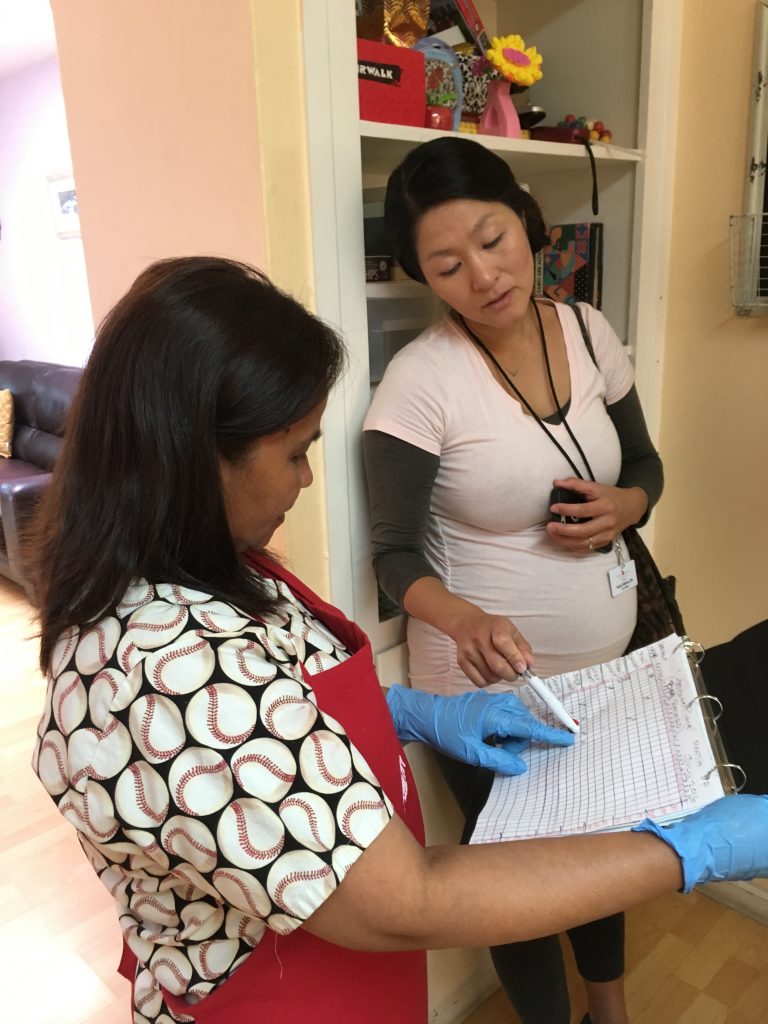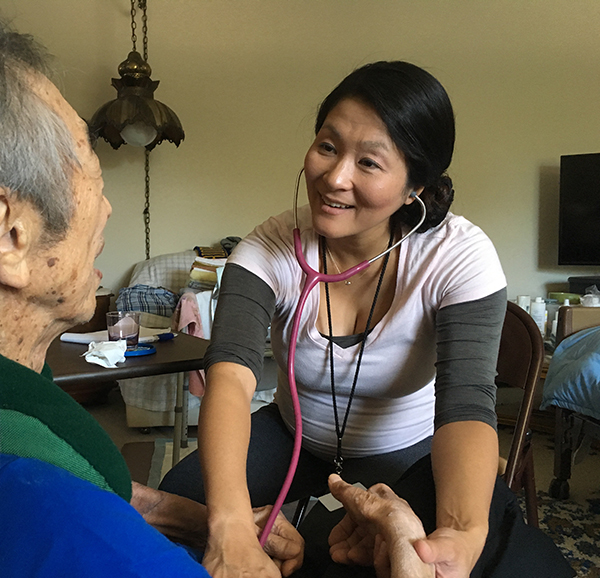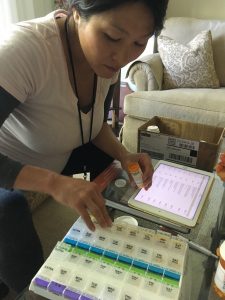Rounds with a hospice nurse: Compassion in action
 When you’re a hospice nurse, each day is different. The schedule, your patients, and their needs vary; the one constant is compassion.
When you’re a hospice nurse, each day is different. The schedule, your patients, and their needs vary; the one constant is compassion.
Mission Hospice RN Case Manager Naoko Ishikawa sees each of her 12-16 patients at least once a week, and more often if their symptoms call for it. She shares the details of a recent day in which she visited five patients.
Her morning starts with a call from Donald, whose mom, Grace – one of Naoko’s patients – had fainted. Naoko heads straight to Grace’s assisted living facility in San Mateo. Donald meets her there, and they review the events with Grace’s caregivers. “We work as a team,” Naoko says, and the trust between them is obvious.
In her 90s, Grace is in bed, frail but conversant. Naoko squats down to look in her eyes. Grace seems reassured by Naoko’s presence, and reports that she feels fine. Naoko takes Grace’s blood pressure, which is strong. She’s confident that Grace’s fainting spell was caused by constipation. Naoko texts Dr. Salpeter to ask about adjusting Grace’s medication to address the issue, and immediately gets the go-ahead.
Naoko gives the caregiver the new instructions, notes this in the patient’s chart, and checks to see that the supplies she’d ordered last week were delivered. An hour later, after making sure Grace is comfortable, Naoko heads to Redwood City to see her first regularly scheduled patient.
 Sharon is thrilled to see Naoko for the second time this week. Almost 90 years old, her husband Herbert has been in hospice care for nine months, and the family has developed a close relationship with their Mission Hospice team. “I’m always relieved when Naoko comes,” Sharon says.
Sharon is thrilled to see Naoko for the second time this week. Almost 90 years old, her husband Herbert has been in hospice care for nine months, and the family has developed a close relationship with their Mission Hospice team. “I’m always relieved when Naoko comes,” Sharon says.
Herbert is watching TV in the living room, and Naoko scoots a chair up close to him. “What did you eat this morning?” she asks. “How is your stomach feeling?” His voice is quiet; he is wheezing, and hard to understand. “Are you dizzy? No? Are you nauseous?”
Naoko is a calm, gentle presence. She takes his vital signs and listens to his stomach. She can tell he needs a suppository to help relieve his constipation – a common problem at the end of life.
With that taken care of, Naoko checks on his pain. She reminds Sharon how to recognize when he’s in pain, and when it would be appropriate to apply a heating pad or give him medicine.
Being a caregiver can be exhausting. As they chat at the kitchen table, Naoko reminds Sharon that she can call any time for support. Naoko assures her she’ll be back in a few days. The visit has lasted well over an hour.
Back in San Mateo, Naoko’s next patient, Lillian, is in a 12-bed assisted living facility. The nurse meets with her caregivers to review changes in Lillian’s condition, making sure all of their questions are answered. Coordination with facility staff is an essential part of her job.
Almost 101, Lillian is comfortably asleep. Naoko sits quietly next to her, watching her breathe. She feels Lillian’s feet to assess her circulation. Naoko also checks Lillian’s supplies. Pads and gloves are running low, so Naoko texts a resupply order that will be delivered tomorrow.
Back in the car, Naoko says she drives an average of about 100 miles a day visiting patients throughout the peninsula. Her radio is tuned to classical music, which helps relax her between visits.
Her next stop is in Burlingame to see Vern, who recently injured his arm in a fall. She adds gauze and tape to her bag before heading into his board and care facility.
 Naoko is greeted warmly; she’s been working with the staff here for several months. In the office, Naoko pulls out Vern’s binder, which contains his plan of care, chart of medicines, and visit notes. She makes a mental note that one of his medicines needs to be refilled.
Naoko is greeted warmly; she’s been working with the staff here for several months. In the office, Naoko pulls out Vern’s binder, which contains his plan of care, chart of medicines, and visit notes. She makes a mental note that one of his medicines needs to be refilled.
In Vern’s suite, Naoko cleans his wound, letting him know it’s healing well. As she works, she asks about his pain and his sleep. Vern’s neurodegenerative disease makes him hard to understand, but Naoko makes out his words.
She is kind and gentle, laughing with him. “We build trust with patients over time,” she says. “When I spend months caring for patients, I really get to know them and their families.”
She tells Vern that she’ll be back in a few days for his next dressing change. Back in the parking lot, she calls the pharmacy for the refill; Dr. Lee has already approved it, and the medication will be delivered the next day.
Her last visit today is to Rita, who lives with her husband Alan in a retirement community. Naoko especially likes seeing patients in this neighborhood of San Mateo, because the nearby Japanese garden is one of her favorite spots for a break.
First, Naoko confers with the staff at the community, working out how they can all support Rita and Alan – her full-time caregiver.
The couple’s lovely condo is filled with orchids, art, and family photos. When Naoko arrives, Rita is resting in bed; Alan is making sandwiches.
Rita is battling lung cancer and shingles. Oxygen makes it easier for her to breathe, but she’s short of breath, and getting around takes some effort. Naoko listens to Rita’s lungs, and notices some swelling in her ankles. The nurse reminds her to keep her feet elevated – the goal is to keep Rita ambulatory.
Naoko also recommends that Rita use her shower chair, which will help save her energy “for something better.” Rita smiles and nods – she would like to be able to resume visits with her friends.
Alan and Naoko move to the living room, letting Rita rest. Respectful of the fact that independence is important to the couple, she gently reminds Alan that his Mission Hospice social worker can help him find in-home help when he is ready. This kind of teamwork is part of what Naoko loves about Mission Hospice. “I get a lot of support here,” she says.
When she is satisfied that Alan has no more questions, Naoko prepares Rita’s medications for the week. Dr. Boblett has already coordinated with the specialist Rita saw yesterday, and Naoko can see the updated medications list on her iPad. She fills Rita’s weekly pillbox, and reminds Alan to make sure Rita takes her medications so she can stay ahead of the pain.
Rita’s eyes are closed, and Naoko whispers her goodbyes. Back in the Mission Hospice office, she will finish her charting for these patients, check in with her colleagues, and finalize details for tomorrow’s visits.
Naoko loves that she can spend the day caring for others (even while seven months pregnant), and considers the time she spends with patients in their home a gift.
“Hospice nursing can be sad – but if I can reduce someone’s pain and help provide a good death, that is the most beautiful thing I can do.”
It was a beautiful day.

